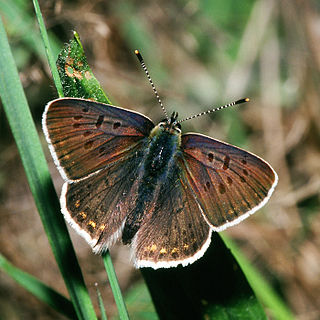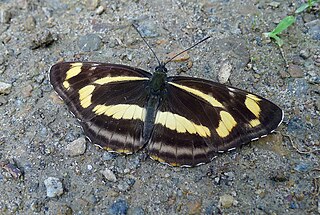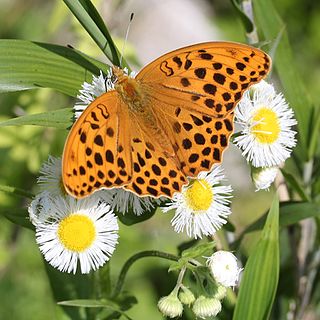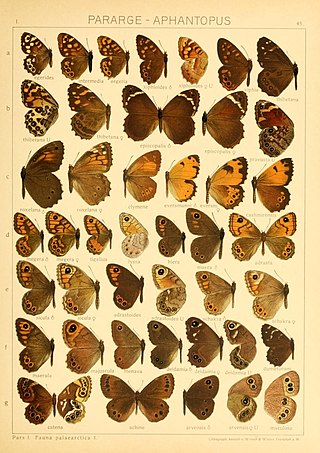
The silver-washed fritillary is a common and variable butterfly found over much of the Palearctic realm – Algeria, Europe and across the Palearctic to Japan.

The brown hairstreak is a butterfly in the family Lycaenidae. The range includes most of the Palaearctic.

Apatura iris, the purple emperor, is a Palearctic butterfly of the family Nymphalidae.

The dark green fritillary is a species of butterfly in the family Nymphalidae. The insect has a wide range in the Palearctic realm - Europe, Morocco, Iran, Siberia, Central Asia, China, Korea, and Japan.

The dot moth is a moth of the family Noctuidae. The species was first described by Carl Linnaeus in 1761. It is a very distinctive species with very dark brown, almost black, forewings marked with a large white stigma from which the species gets its common name. The hindwings are grey with a dark band at the termen. The wingspan is 38–50 mm. It flies at night in July and August and is attracted to light, sugar and flowers.

Apatura ilia, the lesser purple emperor, is a species of butterfly native to most of Europe and east across the Palearctic. It is named for its similarity to the purple emperor butterfly.

Amblopala is a Palearctic and Indomalayan butterfly genus in the family Lycaenidae. The genus is monotypic containing the single species Amblopala avidiena the Chinese hairstreak. It is a small butterfly found in the Naga Hills of India and in China

Lycaena tityrus, the sooty copper, is a butterfly of the family Lycaenidae. It is found in Europe.

Sinia is a genus of butterflies in the family Lycaenidae first described by Walter Forster in 1940. The species of this genus are found in the far eastern Palearctic realm.

Aldania is a butterfly genus of the Limenitidinae. The genus is confined to the temperate East Palearctic. Aldania is closely related to Neptis.

Mimathyma schrenckii is a butterfly found in the East Palearctic that belongs to the Nymphalidae family.

Argynnis anadyomene is a butterfly found in the East Palearctic that belongs to the browns family.

Dilipa fenestra is a butterfly found in the East Palearctic that belongs to the browns family.

Aldania yunnana is a butterfly found in the Palearctic where it is endemic to China that belongs to the browns family.

Aulocera magica is a butterfly found in the East Palearctic that belongs to the browns family (Nymphalidae). It is endemic to western China and Tibet. The species was first described by Charles Oberthur in 1886.

Aphantopus arvensis is a butterfly found in the Palearctic that belongs to the browns family. The species was first described by Charles Oberthur in 1876. It is endemic to western and central China.

Athyma disjuncta is a butterfly found in the Palearctic that belongs to the browns family. It is endemic to China

Chitoria modesta is a butterfly found in the East Palearctic that belongs to the browns family. It is endemic to Southwest China (Yunnan)


















